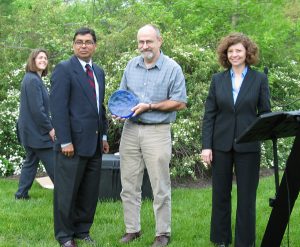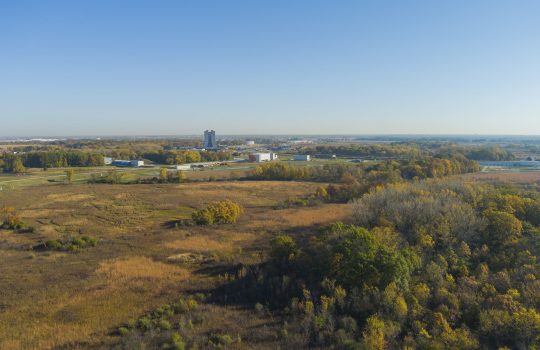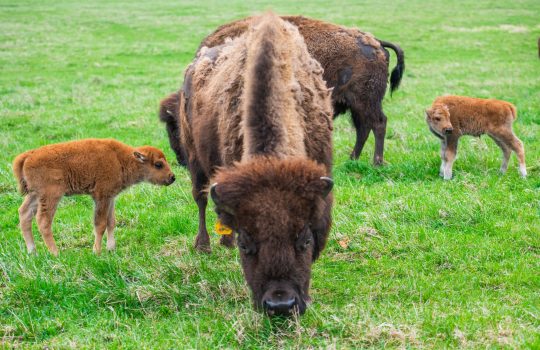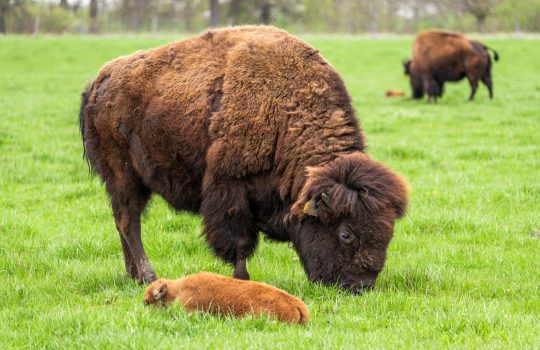 BATAVIA, Ill. – On Tuesday, May 11, 2004, the U.S. Environmental Protection Agency and Chicago Wilderness presented the Department of Energy’s Fermi National Accelerator Laboratory with a 2003 Conservation and Native Landscaping Award at a ceremony in Chicago’s Jackson Park. Bharat Mathur, Acting Regional Administrator for U.S. EPA Region 5, and Elizabeth McCance, Director of Conservation Programs for Chicago Wilderness, cited Fermilab’s achievement in using native plants in the Main Injector Wetland Mitigation Project.
BATAVIA, Ill. – On Tuesday, May 11, 2004, the U.S. Environmental Protection Agency and Chicago Wilderness presented the Department of Energy’s Fermi National Accelerator Laboratory with a 2003 Conservation and Native Landscaping Award at a ceremony in Chicago’s Jackson Park. Bharat Mathur, Acting Regional Administrator for U.S. EPA Region 5, and Elizabeth McCance, Director of Conservation Programs for Chicago Wilderness, cited Fermilab’s achievement in using native plants in the Main Injector Wetland Mitigation Project.
“These awards recognize outstanding examples where people have used native plants to bring beauty and diversity to the areas in which we live,” McCance said. “The recipients of today’s awards are models for the rest of us. They have changed their sites into thriving natural communities and made them a better place to work and live.”
According to the Environmental Protection Agency, 31 percent of the United States’ plant species grow in wetlands, and up to one-half of North American birds nest or feed in them. Wetlands cover only five percent of the United States’ land surface, but they are such important ecosystems that for every acre destroyed, the Army Corps of Engineers requires one and half acres to be replaced.
In 1991, Fermilab’s Main Injector had to be built through six acres of wetlands. The Army Corps of Engineers required a replacement of 10.1 acres, of which 3.1 acres are sedge meadow and seven acres are forested wetland. Fermilab planted the first native wetland vegetation in 1992, and the Corps of Engineers monitored the wetlands area until it met the basic requirements in 1997.
Approximately 65 percent of all wetland mitigation projects fail nationwide because of a lack of water and poor design. Rod Walton, Head of Fermilab’s Land Management Sub-Committee, explains that most mitigations are parking lots or abandoned fields after twelve years. Fermilab’s wetland area has not only survived; it is flourishing.
“We really went beyond the basic requirements and ordered many different species of plants for the area,” Walton said. “It is about as close to the natural thing as you can get. We were very fortunate because our contractor did a nice job grading. They saved the soil from the Main Injector construction, and spread it on the new area.”
Dense sedges, which are grass-like plants, are the main wetland species in the three acres of the sedge meadow wetland. Mountain mint and marsh milkweed also grow in large numbers. But healthy and diverse plants are only one component of a healthy wetland ecosystem; insect life is another. Fermilab’s Land Management Sub-Committee has spotted Bronze Coppers and Dion Skippers, both wetland species butterflies, in the sedge meadows, which is a very good indication that the wetland mitigation project is a success.
“Protecting the environment in our daily operations is very important to Fermilab,” said Fermilab Associate Director for Operations Jed Brown. “We are delighted to accept an award that recognizes the laboratory’s commitment to integrating environmental considerations into its planning and decision-making processes.”
Fermilab is a national laboratory funded by the Office of Science of the U.S. Department of Energy, operated by Universities Research Association, Inc.



